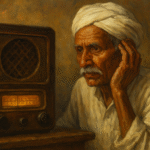Vanishing Professions in India: The Human Touch in Public Art
Fading Ink on Rusted Tin: A Story in Disappearance
In the corners of old Indian towns, on shuttered shops and fading school walls, you’ll still find them—painted signs with curling letters, often chipped, always beautiful. “Tailor Master.” “STD/ISD.” “Savitri Beauty Parlour.” Hand-written boards in Hindi, Urdu, Tamil, Bengali. Bright reds, deep blues, paint peeling like memory.
But every year, there are fewer.
The people who once painted our cities into being—the signboard artists, calligraphers, wall painters—are disappearing. Their work is being replaced by digital flex printing, shiny vinyl, corporate logos with no trace of the human hand.
This is not just a change in technique. It’s the quiet erasure of a profession, and with it, a way of seeing.
Who Painted the Town?
For decades, these artists were the invisible city-makers.
- They worked from roadside stools and tin workshops.
- Their brushes danced across wood, tin, canvas, walls.
- They painted political slogans, film hoardings, street directions, rickshaw backs, and school names.
Every board had a signature style—sometimes humorous, sometimes oddly poetic, often laced with spelling “mistakes” that added charm, not error. These weren’t just signs. They were visual languages of a region.
Yet, their creators were rarely credited. Most lived hand-to-mouth. Their art was always public, but never prestigious.
The Politics of Erasure
When digital printing arrived, it came cheap, fast, and uniform. Shops that once hired local painters now imported ready-made boards. Government contracts moved toward machine-made visibility.
This shift wasn’t just about technology—it also reflected power, aesthetics, and access:
- Hand-painted signs were regional, vernacular, textured.
- Digital prints are often urban, English-heavy, and brand-oriented.
In the process, a thousand small languages of color and form were lost.
Signs of Resistance
And yet, some artists continue. In pockets of Old Delhi, Pune, Kolkata, and Chennai, you’ll find:
- Truck painters still adorning bumpers with floral Urdu.
- Street calligraphers writing house names in old Devnagari.
- Independent artists reviving hand-painted ads as heritage art.
There are photographers documenting them. Filmmakers recording them. And young designers learning from them. Because behind every fading sign lies a story—and someone’s livelihood.
Why It Matters
We often romanticize “old-world charm,” but forget to ask:
Who made it? Who lost work when it changed?
This blog is not just a walk through disappearing signs—it’s a tribute to the workers who wrote us into space. The painters who gave personality to cities, and identity to corners. The nameless hands who signed the streets.
Their art may not hang in galleries. But they wrote public poetry—and we’re still reading it, even as it fades.
Also Read:


